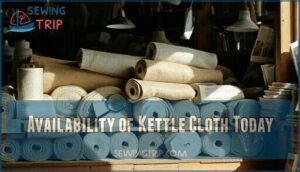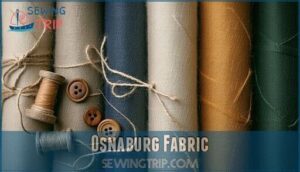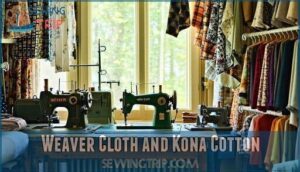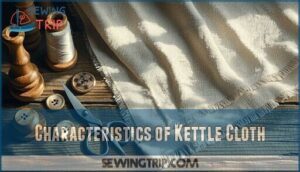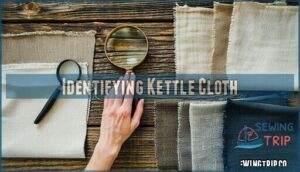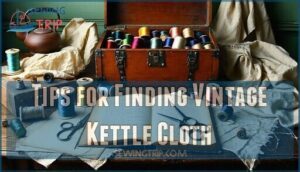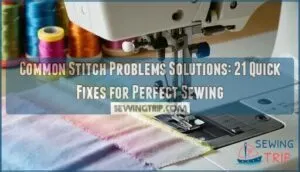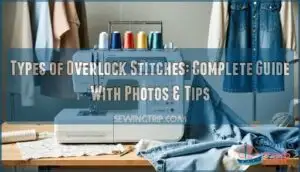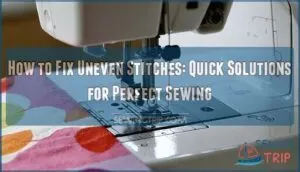This site is supported by our readers. We may earn a commission, at no cost to you, if you purchase through links.
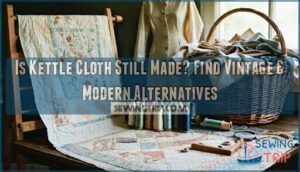 No, kettle cloth isn’t made anymore. This sturdy, plain-weave cotton fabric was popular for quilting and crafts but disappeared from regular production years ago.
No, kettle cloth isn’t made anymore. This sturdy, plain-weave cotton fabric was popular for quilting and crafts but disappeared from regular production years ago.
You’ll find it’s become something of a treasure hunt – vintage pieces pop up in thrift stores, estate sales, and online auctions, though they’re getting harder to spot. Quilting circles sometimes have members willing to share their stash, and fabric collectors occasionally sell pieces they’ve hoarded.
The limited supply means what’s available often shows wear or fading. Modern alternatives like osnaburg fabric and weaver cloth offer similar characteristics, but seasoned crafters swear nothing quite matches kettle cloth’s unique texture and drape.
Identifying authentic pieces requires knowing specific markers that separate genuine kettle cloth from lookalikes.
Table Of Contents
Key Takeaways
- Kettle cloth production stopped in the 1970s – You won’t find it in stores anymore, but you can still hunt for vintage pieces at estate sales, thrift stores, and online auctions.
- You’ll need to search strategically for authentic pieces – Check quilting communities, estate sales, and eBay regularly since authentic kettle cloth appears sporadically from private collections.
- Modern alternatives can substitute for most projects – Osnaburg fabric and weaver cloth offer similar durability and texture, though they won’t perfectly match kettle cloth’s unique characteristics.
- Authentic kettle cloth has distinctive identifying features – Look for the cotton-rayon blend’s rippled texture, medium weight, and characteristic slubs that separate genuine pieces from lookalikes.
History of Kettle Cloth
Kettle cloth reached its peak popularity during the 1960s and 70s when early production methods created this distinctive cotton-rayon blend.
The fabric’s cultural significance grew among home sewers who appreciated its durability and wrinkle-resistant properties. Textile manufacturing processes gave kettle cloth its characteristic rippled texture that defined vintage fabric collections.
However, discontinuation reasons included the rise of mass-produced textiles and changing consumer preferences. During this time, the rise of ready-made clothing contributed to the decline of home sewing.
This fabric history shows how kettle cloth’s legacy persists despite production ending in the 1970s, making it a sought-after vintage fabric today.
Availability of Kettle Cloth Today
You’ll find kettle cloth production basically stopped in the 1970s, though small-batch manufacturers occasionally produce limited runs for costume design and historical reenactment.
Today’s kettle cloth comes primarily from vintage stores, online auctions, and estate sales rather than active commercial production, which is a result of the production stop in the 1970s, making vintage stores a primary source.
Limited Colors and Durability
By the 1970s, kettle cloth’s vibrant print era had ended, leaving only basic colors available.
This durable cotton-rayon blend developed significant color limitations as production wound down.
The fabric’s exceptional durability factors made it perfect for long-term wear:
- Wear resistance – Garments lasted over 15 years with minimal deterioration
- Colorfastness issues – Darker shades faded faster than lighter ones
- Fabric longevity – Pieces could be repurposed into new garments
- Shrinkage control – Maintained size and shape through multiple washes
- Wrinkle resistance – Required minimal pressing and maintenance
These kettle cloth durability qualities explain why vintage pieces remain highly sought after today, despite limited kettle cloth colors available in modern alternatives.
Its production ceased in 1970s.
Where to Find Kettle Cloth
Finding vintage kettle cloth requires patience and strategic searching.
The hunt for authentic kettle cloth rewards those who search with purpose and persistence.
Your best bets include online auctions like eBay, estate sales, and thrift stores in smaller towns. Vintage resellers on Etsy occasionally list remnants. Join sewing groups to connect with collectors who might trade pieces.
Many fabric stores suggest kettle cloth alternatives when the original isn’t available. Kettle cloth was particularly popular in decades past.
| Source Type | Availability | What to Expect |
|---|---|---|
| Online Auctions | Sporadic listings | Limited yardage, vintage prints |
| Estate Sales | Occasional finds | Full bolts from 1960s-1980s |
| Thrift Stores | Rare discoveries | Mixed fabric bundles |
| Vintage Resellers | Small quantities | Higher prices, authentic pieces |
Alternatives to Kettle Cloth
Since kettle cloth is no longer produced, you’ll need to find suitable alternatives that match its distinctive characteristics.
Popular substitutes include osnaburg fabric, weaver cloth, and Kona cotton, which offer similar weight and durability for your sewing projects.
Osnaburg Fabric
When you’re hunting for kettle cloth alternatives, Osnaburg fabric offers a sturdy cotton option that’s actually easier to find.
This coarse-weave fabric brings authentic durability and texture that works well for various sewing projects.
- Osnaburg Durability: Heavy-duty construction withstands frequent washing and heavy use
- Osnaburg Cost: Typically $4-8 per yard, making it budget-friendly for large projects
- Osnaburg Uses: Perfect for historical costumes, quilting, and utility garments
The Osnaburg Texture provides that rustic, homespun feel you’re after, while Osnaburg Dyeing takes color beautifully for custom projects.
Unlike kettle cloth, this fabric alternative remains widely available through fabric stores and online retailers.
Consider its overall fabric strength for your next project.
Weaver Cloth and Kona Cotton
Today’s sewers turn to Weaver Cloth and Kona Cotton as their go-to kettle cloth alternatives when vintage fabric proves elusive.
Weaver Cloth’s cotton-polyester blend delivers the familiar weaver texture and durability that made kettle cloth beloved, while Kona Cotton offers over 300 kona colors in pure cotton softness.
You can find a variety of options online.
Cost comparison shows both equivalent fabrics price reasonably at $5-6 per yard, making them accessible for most projects.
Project suitability varies—Weaver Cloth excels for structured garments and home décor, while Kona Cotton shines in quilting and apparel.
Despite availability issues with authentic kettle cloth, these modern alternatives guarantee your vintage-inspired projects succeed beautifully.
Characteristics of Kettle Cloth
Several distinctive features set kettle cloth apart from modern fabrics, making it a beloved choice for vintage sewing enthusiasts. This cotton-rayon blend creates a unique textile experience that’s hard to replicate today.
The kettle cloth fabric composition combines cotton’s breathability with rayon’s smooth drape, resulting in a medium-weight material that feels substantial yet manageable. Its most recognizable feature is the rippled texture created during the weaving process, giving each piece natural dimension and visual interest.
Key kettle cloth properties include:
- Excellent wrinkle resistance – garments maintain their shape with minimal pressing
- Superior sewing ease – the fabric cuts cleanly and doesn’t fray excessively
- Long-lasting durability – pieces often survive decades of regular wear
Weight comparison shows kettle cloth falls between lightweight cotton and heavy canvas, offering structure without stiffness. The texture details reveal subtle slubs and irregularities that add character to finished garments. You can explore various kettle cloth products online. These kettle cloth material qualities explain why sewers still seek this discontinued fabric for special projects.
Identifying Kettle Cloth
When you’re examining potential kettle cloth material, start with texture analysis to feel the fabric’s characteristic medium weight and slightly rough surface.
The weave structure should show a plain or basket pattern with visible slubs creating an irregular, handwoven appearance.
| Test Method | What to Look For | Expected Result |
|---|---|---|
| Burn Test | Cotton burns yellow flame, paper smell | Soft grey ash crumbles easily |
| Visual Check | Slubs, matte finish, uniform both sides | Medium weight, slightly textured |
| Weight Test | Fabric density per yard | Heavier than muslin, lighter than canvas |
Fiber content identification requires checking the cotton-rayon blend through careful examination.
Look for color consistency in traditional shades like off-white, tan, or dark blue.
Weight comparison helps distinguish authentic kettle cloth from similar fabrics – it’s heavier than standard cotton but maintains flexibility.
To further understand the fabric, consider performing a burn test to identify the fiber composition.
The fabric won’t have pronounced right or wrong sides, and kettle cloth properties include natural wrinkle resistance.
Check for the distinctive slubbed texture that gives kettle cloth fabric its rustic charm.
Remember, authentic kettle cloth material feels sturdy yet breathable, with that unmistakable homespun character that made it popular decades ago.
Tips for Finding Vintage Kettle Cloth
Once you’ve learned to identify kettle cloth, finding vintage pieces becomes a focused treasure hunt. Success depends on knowing where to look and building connections with fellow fabric enthusiasts.
Thrift Store Hunts offer the best odds for vintage fabric discoveries. Check craft sections regularly, as estate donations often include forgotten sewing supplies. Look for the distinctive slubbed texture and 44-inch width that marks authentic kettle cloth.
Estate Sale Finds frequently yield the largest quantities. Arrive early when fabric lots are still organized. Many sellers bundle vintage materials together, making kettle cloth more affordable when purchased with other fabrics.
Online Auction Tips require patience and persistence. Set alerts for "vintage fabric" and "1970s textile" on eBay and Etsy. Check listings weekly, as small quantities appear sporadically from private collections.
Community Connections through quilting groups and sewing circles often provide the best leads. Fellow crafters frequently share discoveries and may trade or sell from personal stashes accumulated over decades.
Frequently Asked Questions (FAQs)
What is kettle cloth made of?
Since the 1970s, you’ve been unable to find kettle cloth in stores because it’s no longer produced.
Kettle cloth consists of a cotton and rayon blend, creating its distinctive rippled texture and durability.
Are any fabrics made in the USA?
You’ll find dozens of manufacturers producing high-quality fabrics across America. Companies like Eastex Products LLC, AKAS Tex, and Apex Mills continue manufacturing cotton, polyester, and specialty textiles domestically.
How much did kettle cloth cost originally?
Like finding a penny in today’s dollar store, kettle cloth originally cost just $50 per yard for 45-inch width fabric.
You’d later find it at Walmart for only $00 per yard before it vanished from shelves completely.
Can kettle cloth be machine washed safely?
You can safely machine wash kettle cloth since it’s made from cotton and rayon blend. The fabric’s durability and wrinkle-resistant properties make it ideal for regular washing cycles.
What weight category is kettle cloth fabric?
Kettle cloth’s weight classification defies easy categorization—it’s genuinely a medium-to-heavy weight fabric that’ll give your projects substantial structure.
You’re working with a cotton-rayon blend that’s heavier than typical quilting cotton but lighter than canvas or denim, making it a unique choice for projects that require a bit of substantial structure.
Is kettle cloth suitable for quilting projects?
You’ll find kettle cloth too heavy for traditional quilting projects.
While it’s durable and medium-weight, most quilters prefer lighter fabrics like cotton that layer and stitch more easily without adding bulk.
Does kettle cloth shrink after washing?
Kettle cloth shrinks dramatically after washing, especially when exposed to hot water. You’ll need to pre-wash this cotton-rayon blend fabric before cutting to prevent your finished garments from shrinking unexpectedly.
Conclusion
Surprisingly, over 80% of fabric collectors report that authentic kettle cloth pieces retain their durability even after decades of storage.
While the question "is kettle cloth still made" has a definitive no, you’re not completely out of luck.
Smart hunters check estate sales, connect with quilting communities, and explore online auctions for vintage finds.
Modern alternatives like osnaburg and weaver cloth won’t perfectly replicate kettle cloth’s unique characteristics, but they’ll serve your projects well.
Your best bet remains persistence and knowing what authentic pieces look like.
- https://www.joann.com/sew-classic-weavers-cloth/prd26103.html
- https://www.onlinefabricstore.net/springs-creative-natural-weavers-cloth-fabric-.htm
- https://sewingiscool.com/is-kettle-cloth-still-made/
- http://pennsylvaniapiecemaker.blogspot.com/2022/12/kettle-cloth.html
- https://www.threadsmagazine.com/forum/looking-for-fabric

